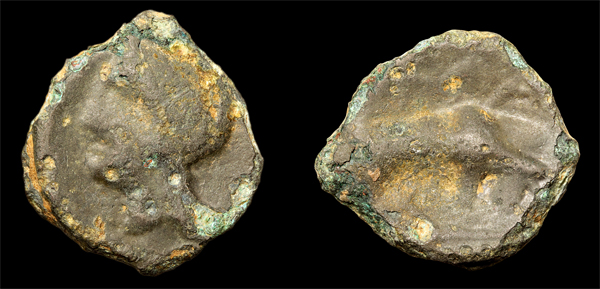
Unique ID: 107
Thurrock potins were the first British coinage, or the second, and were minted in Kent around 120-100 BC. Or Essex around 100-90 BC. Or 150 BC. Regardless of who minted them or when, the reason they were minted was to, err, erm. Ok, for such a common coin, it turns out that we know very little about them.
Thurrock potins are named after the 1987 hoard found in Thurrock which contained 2150 coins, all in various states of abstraction. They were cast from bronze and because each coin comes from a unique mould, there’s no way to sequence the coins accurately like we can with struck coins. They are generally ordered by similarity to the prototype. The idea is that coins that look like the original are the oldest, and those that are effectively blobs and lines are the most recent. This kind of artistic degradation can take a long time with struck coins, but it is thought that new moulds were made by pressing one of the most recent coins into clay, which means the design degraded rapidly. As such, we have no real idea if the entire series was minted over a number of years, or in a couple of days. This coin is a “Chicken-Head” type, which comes around midway through the sequence.
The coins are ultimately copied from a struck bronze coin from Massalia which has Apollo’s head on the obverse and a butting bull on the reverse, but it’s not known if they were copied directly from this, or via a Gaulish copy.
They are mainly found in Kent, so have been assigned by most to the Cantiaci. John Sills, in “Gaulish and Early British Gold Coinage” (p348), says Kent was “the only region where relatively low-value items could be purchased with cast bronze and change could be given, at least in theory, for gold coin”. However, they are found over a large area with findspots as far apart as Wessex and the Humber basin. Van Arsdell, who studied the hoard, attributes them to the Trinovantes and Catuvellauni, pointing out that the hoard they are named after was found in Essex, and not Kent. He believes that the hoard was composed of coins rejected by the mint, so was buried near the mint. His reasoning is that “one coin had a large protrusion of flash which would have broken off had the coin been moved any great distance”, and the Hoard contained “a complete corpus of the series, [so] would have been very difficult to assemble outside the mint – it very well may be a hoard of mint scrap”.
A counter to this is that the only other hoards (Folkestone and Gravesend) of this type are from Kent (see “Iron Age Coinage in Kent: A Review of Current Knowledge” by David Holeman). Of course, even this isn’t clear cut. Holman says “possibly Gravesend” and there is no such hoard listed in “Coin Hoards in Iron Age Britain” by Philip de Jersey, so it’s unclear if this hoard exists. As for the Folkestone hoard, it was originally thought to contain Massaliot issues rather than the British derivatives. David Holeman is “virtually certain that these coins were produced locally”, but that leaves room for doubt and using it as evidence for a Kentish mint rather than an Essex mint should be treated with caution.
Many numismatists consider these coins to be the first British coinage, and date them to 120-100 BC accordingly. Van Arsdell thinks they were influenced by the Kentish Flat Linear Potins and assigns the later date range of 100-90 BC. Colin Haselgrove says they could date to 150 BC based on a single example found in a archaeological dig (Maiden Castle), although there seems to be some doubts about the context. An example of a Group A Flat Linear Potin, which is thought to have been the first of the series following the Thurrock Potins, was found in an (almost) secure context which dates it to before the first century BC (See “A New Classification System for the Flat Linear Potin Coinage”, David Holman). If the following series was already being produced by 100 BC, then the Thurrock Potins had probably ceased by then. David Holeman said in 2018 that they date “…to perhaps c. 175-150 BC”.
Without doing further research, I’m going to select the 120-100 BC date ranges, assume that the Thurrock Potins came before the Flat Linear Potins, and use the commonly accepted Cantiaci attribution, although I have to admit that I suspect Van Arsdell may be correct in assigning these to the Trinovantes and Catuvellauni.
